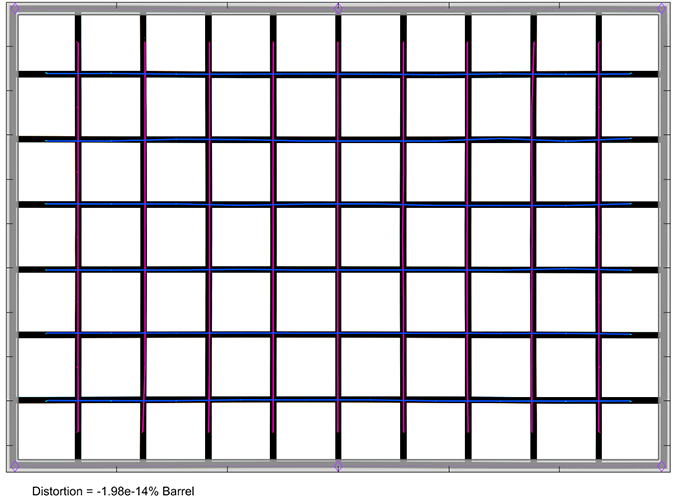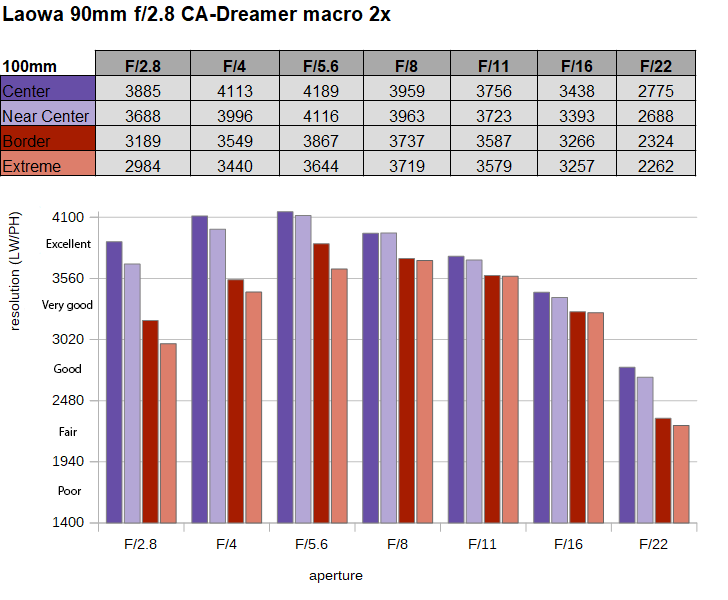|
Laowa 90mm f/2.8 2x Ultra-Macro APO - Review / Test Report - Analysis |
|
Lens Reviews -
Canon EOS (Full Format)
|
|
Page 2 of 3

Distortion
Due to the lack of electronic coupling, the Laowa lens has to rely on its original capabilities regarding distortion, vignetting and CAs.
With respect to image distortions, the Laowa 90mm f/2.8 2x Ultra-Macro APO has no issues - at all. The lens is fully corrected.

Vignetting
The vignetting figures are in line with what you can expect from such a lens. At f/2.8 there is some visible light falloff albeit it's far from being excessive at ~1.5EV (f-stops) in the full format scope. Stopping down reduces the issue but it's a gradual process and there is still some light falloff (~0.8EV) present at f/8.

MTF (resolution) at 45 megapixels
The resolution characteristic is pretty impressive. The center resolution is already great at f/2.8. The outer image field isn't quite on this level but still manages to achieve good marks. Stopping down to f/4 has a fairly substantial impact lifting the borders/corners to very good levels. The peak performance is reached at f/5.6 with a great center and a very good to excellent outer image field. Diffraction has a limiting effect from here on albeit you won't really notice it at f/8 yet. f/16 remains usable but you should stay clear of f/22.
Our sample had a slight centering issue which prevented better results at f/2.8. The field curvature is minimal.
Please note that the MTF results are not directly comparable across the different systems!
Below is a simplified summary of the formal findings. The chart shows line widths per picture height (LW/PH) which can be taken as a measure of sharpness.
If you want to know more about the MTF50 figures, you may check out the corresponding Imatest Explanations

MTF (resolution) at 30 megapixels
Not everybody is using a high megapixel body so let's have a look at how the results turn out at 30 megapixels.
Unsurprisingly, the results are better on pixel level due to the reduced pixel density. You can easily use the lens at f/2.8 here. The slight corner softness is mostly gone. The results are, of course, tack sharp at medium aperture settings again. f/22 remains unimpressive and should best be avoided.
Please note that the performance numbers are higher at f/22 compared to the 45mp chart because the edges are "sharper" and, as such, more receptive to the mild default sharpening that we apply during RAW conversion.

Chromatic Aberrations (CAs)
Lateral CAs (color shadows at the image borders) are reasonably well controlled, with an average CA pixel width of around 1.1px. Remember that there is no auto-correction available for this lens but you can easily remove these CA traces manually during post-processing if needed.

Bokeh
Given the large max aperture and macro capabilities, the quality of the bokeh will be an interesting aspect for most users.
Out-of-focus highlights are nicely rendered. The discs have a very smooth inner zone and minimal outlining effect. Please note that the outlining gets emphasized when stopping down. The circular disc shape is maintained from f/2.8 to f/5.6 which is better than on most lenses. The lens features no less than 13(!) aperture blades which certainly helps in this respect.
 The above is true for the image center. As so often, the circular disc shape deteriorates to cat eyes in the image corners - a mechanical vignetting effect. However, the deterioration is comparatively moderate. The "circular shape" zone broadens at f/4 although the corner discs look less pleasing. Circular corner discs require stopping down to f/5.6.
As far as the general blur is concerned, there are two flavors to discuss here. The background blur (shown to the left below) isn't ideal with some rough edges whereas the foreground blur is much smoother.
The above is true for the image center. As so often, the circular disc shape deteriorates to cat eyes in the image corners - a mechanical vignetting effect. However, the deterioration is comparatively moderate. The "circular shape" zone broadens at f/4 although the corner discs look less pleasing. Circular corner discs require stopping down to f/5.6.
As far as the general blur is concerned, there are two flavors to discuss here. The background blur (shown to the left below) isn't ideal with some rough edges whereas the foreground blur is much smoother.

Bokeh Fringing
Laowa emphasizes the apochromatic design of the lens. Such a design should suppress axial CAs (LoCAs), also called bokeh fringing. And we can confirm that there are only very faint traces of LoCAs present at f/2.8,
If you scroll across the aperture range below, you may spot that the focus point is shifting towards the front when stopping down (while the focus setting on the lens is the same). These are so-called residual spherical aberrations. We have seen a similar issue in the Canon RF 100mm f/2.8 L USM IS macro already.
|